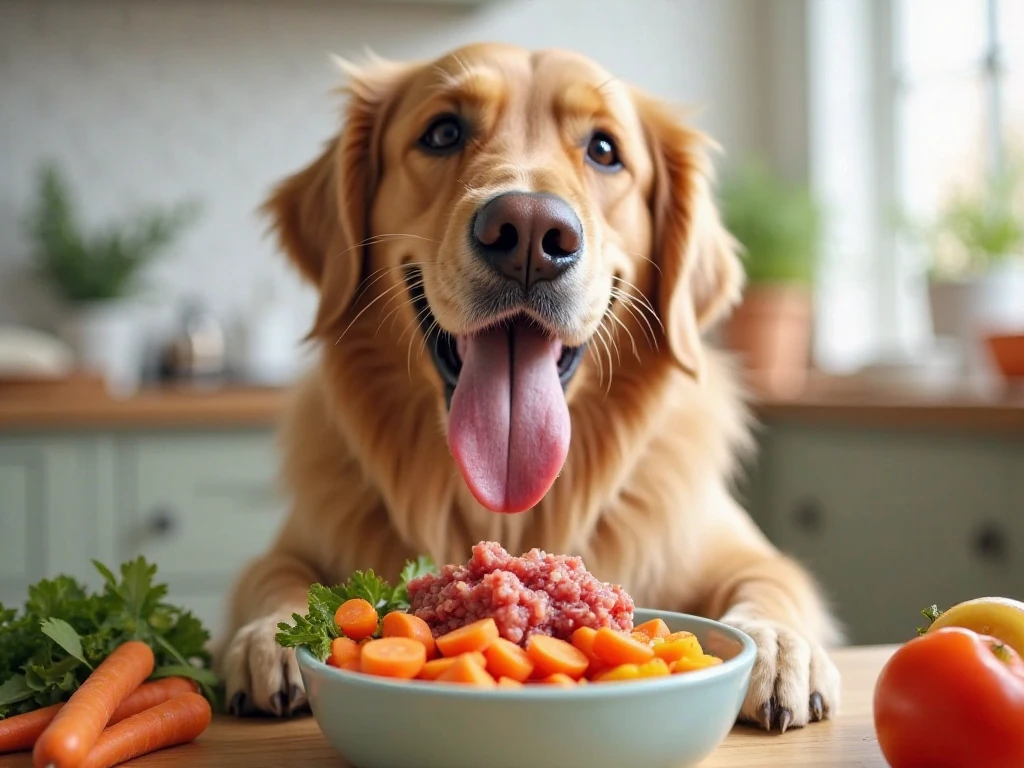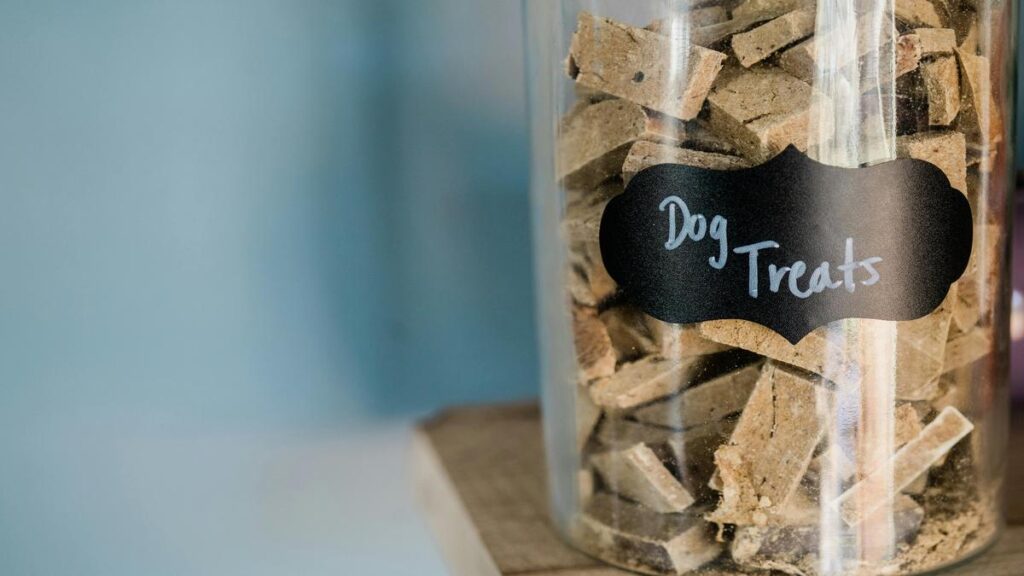If you’re looking for easy ways to start a natural diet for dogs, you’ve come to the right place! Our furry friends deserve the best nutrition, and switching to a natural diet can make a big difference.
In this article, we’ll explore what your pup really needs, share simple recipes, and give you tips for an easy transition.
Let’s dive into the world of dog nutrition and make mealtime exciting for your pup!
Key Points to Remember
- Choose whole foods for your dog’s diet.
- Avoid processed and artificial ingredients.
- Include fruits and veggies like carrots and blueberries.
- Ensure your dog stays hydrated with fresh water.
- Always consult your vet before changing their diet.

Summary
Why Choose a Natural Diet for Your Dog?
So, you’re thinking about switching your dog to a natural diet? That’s awesome! There are plenty of reasons to consider this change. First off, many dog owners notice that their pups have more energy and a shinier coat when they eat natural foods. Just like us, dogs thrive on whole, unprocessed ingredients.
A natural diet often means fewer fillers and artificial additives. Instead of mystery ingredients, you’ll know exactly what’s going into your dog’s bowl. Plus, some dogs have food sensitivities or allergies that can be managed better with a natural diet. It’s all about giving your furry friend the best nutrition possible.
And let’s be honest, who doesn’t want a happy, healthy pup? When you choose a natural diet, you’re investing in your dog’s long-term health. It’s like giving them a little boost for their overall well-being. So, if you’re ready to dive into the world of natural dog food, let’s explore how to get started!
Easy Ways to Start a Natural Diet for Dogs
Starting a natural diet doesn’t have to be overwhelming. Here are some easy steps to help you make the transition smoother for both you and your dog:
- Research and Educate Yourself: Before making any changes, spend some time learning about natural dog diets. There are plenty of resources out there, from books to online articles, that can help you understand the basics. Consider checking out natural diet hacks for budget-friendly options.
- Gradual Transition: Don’t just switch your dog’s food overnight. Mix in a bit of the new food with their current food. Start with about 25% new food and 75% old food, and gradually increase the new food over a week or so. This helps avoid upset tummies. For more tips on transitioning, visit proven methods for a smooth transition.
- Choose Quality Ingredients: Look for high-quality, natural ingredients. Think lean meats, veggies, and whole grains. Avoid foods with artificial preservatives, colors, or fillers. You might find inspiration from healthy and delicious recipes.
- Consult Your Vet: It’s always a good idea to talk to your veterinarian before making significant diet changes. They can offer personalized advice based on your dog’s health needs.
- Keep It Simple: Start with a few basic recipes or commercial natural dog foods. You don’t need to overcomplicate things right away. Explore guides on preparing natural meals for more ideas.
- Observe Your Dog: Pay attention to how your dog reacts to the new diet. Are they more energetic? Do they seem to enjoy their meals? This feedback is crucial.
- Stay Consistent: Once you find a routine that works, stick with it. Consistency is key to ensuring your dog adjusts well to their new diet.
Making the switch can be a fun adventure for you and your dog. You’ll discover new flavors and ingredients together, and it can even strengthen your bond.
Understanding Dog Nutrition: What Do They Really Need?
Okay, let’s get into the nitty-gritty of dog nutrition. You might be wondering, what do dogs actually need to thrive? Here’s a quick breakdown:
- Proteins: Dogs are primarily carnivores, so they need a good amount of protein in their diet. This can come from sources like chicken, beef, fish, or eggs. Proteins help build strong muscles and support overall health.
- Carbohydrates: While dogs don’t need carbs as much as humans do, they still benefit from them. Whole grains like brown rice, oats, or sweet potatoes can provide energy and aid digestion. For a list of healthy options, check out 22 healthy foods your dog will love.
- Fats: Healthy fats are essential for a shiny coat and healthy skin. Look for sources like fish oil or flaxseed oil. They’re packed with omega-3 and omega-6 fatty acids, which are great for your pup’s health.
- Vitamins and Minerals: Just like us, dogs need vitamins and minerals to stay healthy. These can come from fruits and vegetables. Carrots, blueberries, and spinach are all great options to include in your dog’s diet.
- Water: Don’t forget the most important nutrient of all! Fresh water should always be available to keep your dog hydrated.
Understanding these basics can help you create a balanced diet for your dog. It’s all about finding the right mix that suits their needs and preferences.
Homemade Dog Meals: Simple Recipes for Happy Pups
Making homemade dog meals can be a fun and rewarding experience. Plus, you know exactly what’s going into your dog’s food. Here are a couple of simple recipes to get you started:
Chicken and Rice
Ingredients:
- 1 cup of brown rice
- 1 pound of ground chicken
- 1 cup of carrots, chopped
- 1 cup of peas, canned or frozen
Instructions:
- In a large pot, cook the brown rice according to package instructions; set aside.
- In the same pot, add the ground chicken and cook until browned.
- Add the carrots and peas, and cook for another 5 minutes.
- Stir in the cooked rice and mix everything together.
- Let it cool before serving.
Beef and Vegetable Stew
Ingredients:
- 1 pound of lean ground beef
- 1 cup of carrots, chopped
- 1 cup of green beans, chopped
- 1 cup of potatoes, cubed
- 4 cups of water
Instructions:
- In a large pot, brown the ground beef over medium heat.
- Add the carrots, green beans, potatoes, and water.
- Bring to a boil, then reduce heat and let simmer for about 30 minutes.
- Allow it to cool before serving.
These recipes are easy to whip up and can be stored in the fridge for a few days. Just remember to adjust portions based on your dog’s size and activity level.
If you are someone who does not have time to prepare food for your pet, consult a veterinarian about this kibble Dr. Harvey’s Canine Health Miracle Dog Food. and to read about this Reviews
Affordable Dog Food Ingredients You Can Trust
Finding affordable dog food ingredients doesn’t have to be a hassle. Here are some budget-friendly options that you can trust:
- Chicken: Often more affordable than beef or fish, chicken is a great protein source. Look for sales or buy in bulk to save even more.
- Rice: Brown rice is usually inexpensive and a good source of carbohydrates. It’s also easy to cook.
- Vegetables: Carrots, peas, and green beans are typically low-cost and can be bought frozen or fresh. They add essential vitamins to your dog’s diet.
- Eggs: Eggs are a fantastic source of protein and are quite affordable. Plus, most dogs love them!
- Oats: Oats are a great source of fiber and can help with digestion. They’re also usually pretty cheap.
- Sweet Potatoes: These are packed with nutrients and can often be found at a reasonable price, especially in season.
By focusing on these ingredients, you can create a balanced and nutritious diet for your dog without breaking the bank.
Transitioning to a Natural Diet: Tips for a Smooth Change
Transitioning your dog to a natural diet can be a bit tricky, but with the right approach, it can go smoothly. Here are some tips to help:
- Take It Slow: As mentioned earlier, gradually introduce new foods. This helps your dog’s digestive system adjust.
- Monitor Their Reaction: Keep an eye on your dog during the transition. If they seem to have an upset stomach or aren’t eating, slow down the process.
- Use Toppers: If your dog is hesitant to try new food, consider adding a little bit of their favorite treat on top. This can entice them to eat.
- Stay Consistent: Once you’ve made the switch, stick to the new diet. Dogs thrive on routine, so consistency is key.
- Be Patient: It might take some time for your dog to adjust. Don’t get discouraged if they don’t take to it right away.
- Celebrate Small Wins: If your dog tries a new food or seems to enjoy their meals, celebrate it! Positive reinforcement goes a long way.
With a little patience and care, your dog will soon be enjoying their new natural diet.

The Benefits of Raw Feeding Dogs: Is It Right for You?
Have you heard about raw feeding? It’s a popular trend among dog owners who want to provide the most natural diet possible. But is it right for you and your dog?
Raw feeding typically includes raw meat, bones, fruits, and vegetables. Proponents claim it can lead to healthier skin, shinier coats, and improved digestion. Some even say it can help with behavioral issues.
However, it’s not for everyone. Raw diets can be more challenging to balance properly. Plus, there’s the risk of bacterial contamination if not handled correctly. If you’re considering this route, it’s essential to do thorough research and possibly consult with a vet who specializes in raw feeding. For more insights, check out benefits and challenges of raw feeding.
If you decide to go raw, start slowly and monitor your dog closely. It can be a big change, and you want to ensure it’s a positive one.
Easy Dog Meal Prep: Save Time and Money
Meal prepping for your dog can save you both time and money. Here’s how to make it easy:
- Plan Ahead: Set aside a day each week to prepare your dog’s meals. This way, you won’t be scrambling at the last minute.
- Batch Cooking: Make large batches of your dog’s favorite recipes and store them in individual portions. This makes it easy to grab a meal when you’re in a hurry.
- Use Freezer Bags: Store meals in freezer bags or containers. Label them with the date and contents so you know what you have on hand.
- Mix It Up: To keep things interesting for your dog, rotate different recipes each week. This prevents boredom and ensures they get a variety of nutrients.
- Involve the Kids: If you have kids, let them help with meal prep. It can be a fun family activity and teaches them about pet care.
By prepping meals ahead of time, you’ll save money on last-minute purchases and ensure your dog always has healthy food ready to go.
Human-Grade Dog Food: What’s the Difference?
You might have come across the term human-grade dog food. But what does it really mean?
Human-grade dog food is made from ingredients that are safe and suitable for human consumption. This means the quality is higher than typical pet food, which often contains by-products and fillers.
When you choose human-grade food, you’re opting for a product that meets strict safety and quality standards. This can give you peace of mind knowing you’re feeding your dog something nutritious.
However, it’s essential to read labels carefully. Not all human-grade dog foods are created equal. Look for brands that are transparent about their ingredients and sourcing.
Dog Nutrition Tips: Keeping Your Pup Healthy and Happy
Keeping your dog healthy and happy is all about good nutrition. Here are some quick tips to help you along the way:
- Balance is Key: Ensure your dog’s diet includes a mix of proteins, carbs, and fats. Variety is essential for their overall health.
- Watch Portion Sizes: Overfeeding can lead to obesity, which can cause various health issues. Follow guidelines based on your dog’s size and activity level.
- Stay Hydrated: Always provide fresh water. Hydration is crucial for your dog’s health.
- Regular Vet Check-ups: Regular visits to the vet can help catch any potential health issues early. Your vet can also provide tailored dietary advice.
- Listen to Your Dog: Pay attention to how your dog reacts to different foods. If they seem to have an upset stomach or aren’t enjoying their meals, it might be time to adjust their diet.
By keeping these tips in mind, you can help ensure your dog leads a healthy and happy life.
Conclusion
In conclusion, transitioning your dog to a natural diet can be a rewarding journey that benefits both their health and happiness.
By focusing on whole foods, avoiding processed ingredients, and paying attention to your pup’s unique needs, you can create a nourishing meal plan that keeps their tails wagging. Remember, patience and consistency are your best friends in this process.
And don’t hesitate to consult your vet for tailored advice.
So, why not take the plunge? Your furry friend deserves the best! If you’re hungry for more tips and tricks on pet care, be sure to check out more articles at Tech Havela. Happy feeding!
Frequently Asked Questions
What is a natural diet for dogs?
A natural diet for dogs includes whole foods like meat, vegetables, and grains. It’s free from artificial additives and preservatives.
How can I start my dog on a natural diet?
You can start by mixing natural food into their regular meals. Gradually increase the natural food over time.
Are there specific foods I should include?
Yes! Include lean meats, carrots, sweet potatoes, and brown rice. These foods are healthy and safe for dogs.
What foods should I avoid?
Avoid chocolate, grapes, onions, and garlic. They can be toxic to your dog.
How much food should I give my dog?
Start with about 2-3% of your dog’s body weight in natural food. Adjust as needed based on their activity level.
Can I feed my dog a raw food diet?
Yes, but do it carefully. Raw foods can be risky. Make sure to research and consult your vet before starting.
How do I know if my dog likes the new diet?
Watch for tail wagging and happy eating. If your dog enjoys the food, it’s a good sign they like the change!
**Sidnir Vieira**
Founder of TechHavela
A passionate pet and tech content creator, helping dog owners across the U.S. make smarter decisions for their furry friends.



